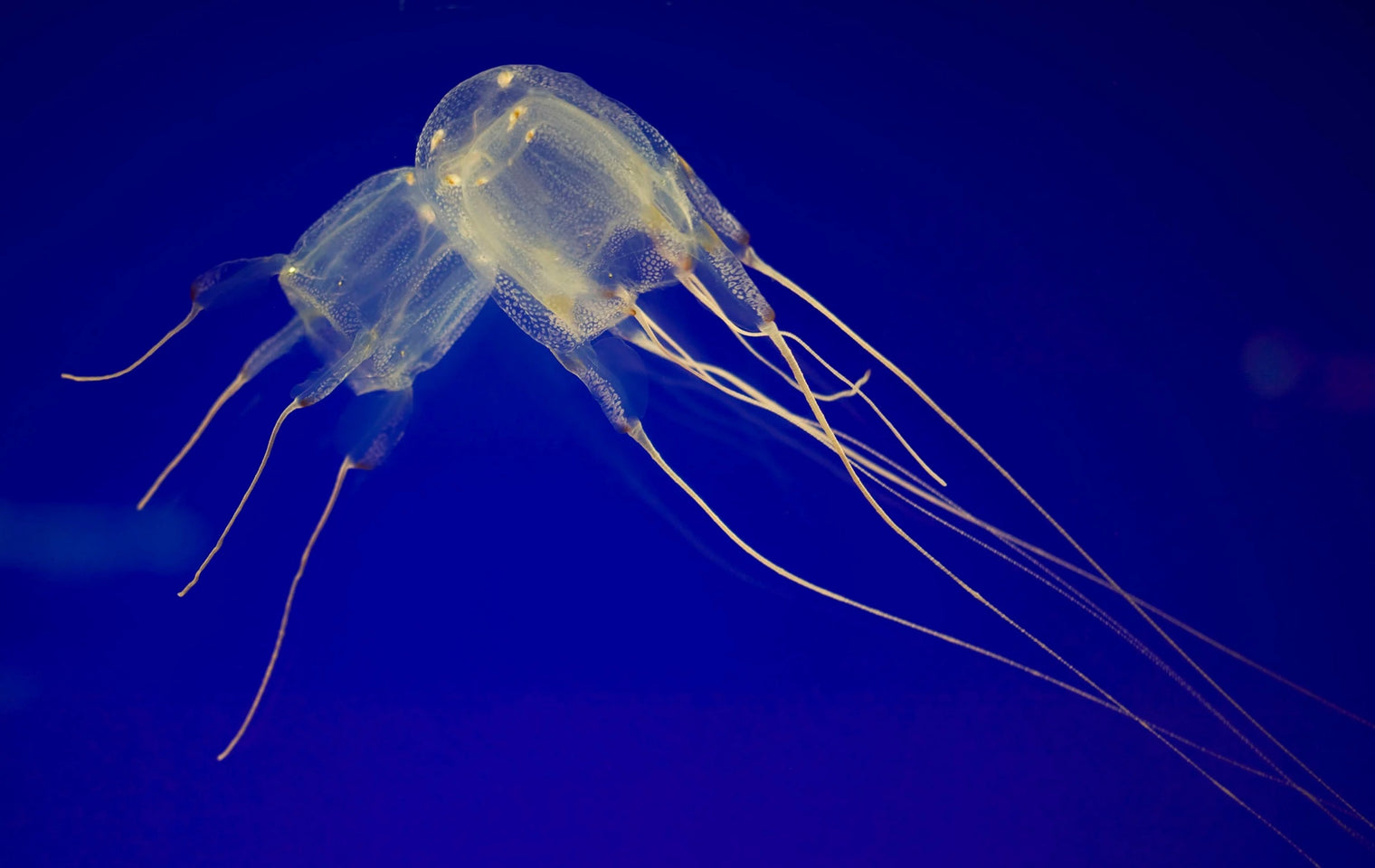The BOX JELLYFISH – Nature’s Deadliest Marvel & The Most Venomous Predator in the Ocean
The Box Jellyfish is one of the ocean’s most fascinating yet feared creatures. Found primarily in the Indo-Pacific region, this nearly invisible predator is both beautiful and deadly, with venom that can cause intense pain and even death in severe cases.
What Makes the Box Jellyfish Special?
With a distinctive cube-shaped body and tentacles that can extend up to 10 feet, the Box Jellyfish (Chironex fleckeri) is unlike any other sea creature. Its transparent bell and advanced nervous system allow it to move through the water with surprising agility, making it a highly efficient predator.

|
Chironex fleckeri, commonly known as the Australian box jelly, and nicknamed the sea wasp, is a species of extremely venomous box jellyfish found in coastal waters from northern Australia and New Guinea to Indonesia, Cambodia, Malaysia and Singapore, the Philippines and Vietnam. |
- Key features include:
- Transparent, cube-shaped bell
- 24 eyes giving it a 360-degree view
- Tentacles lined with venomous cells called nematocysts
- A complex nervous system allowing it to hunt actively
The Ocean’s Most Potent Venom
The Box Jellyfish’s venom is among the most potent in the world (especially Chironex fleckeri). A single sting can cause intense burning pain, nausea, vomiting, and, in extreme cases, heart failure. What makes the Box Jellyfish so dangerous is the speed at which its venom can act, making immediate treatment essential.
Effects of a sting:
- Intense pain
- Red welts or track marks on the skin
- Nausea and vomiting
- Possible heart failure within minutes
Where Can Box Jellyfish Be Found?
While the most dangerous species of Box Jellyfish, such as Chironex fleckeri, are typically found in the Indo-Pacific region and northern Australia, some species have been identified in the United States.
- California waters: A species of Box Jellyfish called Carybdea confusa has been found in California. Though not as dangerous as the Indo-Pacific species, it's still worth being cautious.

- Florida: In Florida, the Tripedalia cystophora Box Jellyfish has been spotted in the red mangroves near Boca Raton. This species is smaller (about 1 cm) and not known to cause severe stings to humans.

- Hawaii: Hawaiian waters are home to three species from the Carybdea genus: C. alata (now is Alatina alata), C. rastoni, and C. sivickisi, none of which pose the same threat as their Indo-Pacific counterparts.
 |
 |
 |
Staying Safe in Box Jellyfish Waters
While encounters with Box Jellyfish are relatively rare, it’s important to remain cautious, especially in regions where they are known to exist:
- Check local warnings: If swimming in tropical or subtropical waters, always check for jellyfish alerts.
- Wear protective clothing: Stinger suits are recommended in areas where jellyfish, including less dangerous species, are common.
- Stay alert: Box Jellyfish can be nearly invisible, so it's crucial to stay vigilant when swimming.
With gradual ocean warming, some species from the Caribbean have been observed moving into areas along the southern and mid-Atlantic coasts of the United States, making it essential to remain cautious even in U.S. waters.
What to Do If Stung by a Box Jellyfish
If you or someone else is stung by a Box Jellyfish, quick action is crucial:
- Call emergency services immediately.
- Rinse the sting with vinegar to neutralize any unfired nematocysts.
- Carefully remove tentacles with tweezers or a gloved hand.
- Apply ice packs or immerse the affected area in hot water for pain relief.
- Seek medical attention as soon as possible.
Why the Box Jellyfish Is Fascinating
Despite its dangerous reputation, the Box Jellyfish is a marvel of nature. Its unique adaptations make it a highly effective predator, and its venom serves an essential purpose in controlling small fish and shrimp populations in the ocean. Scientists continue to study its venom and advanced nervous system, uncovering new insights into this incredible species.
Bringing Jellyfish Magic into Your Home
At Jellyfish Art, we specialize in safe and beautiful pet jellyfish for home aquariums. While the Box Jellyfish remains in the wild, you can bring the magic of jellyfish into your home with species that are harmless and easy to care for. Explore our collection of live jellyfish and jellyfish tanks, perfect for creating a calming, mesmerizing display in your living room or office.
Call to Action:
Want to learn more about jellyfish and how to keep them as pets? Visit Jellyfish Art to explore our range of jellyfish tanks and live jellyfish today!
Learn more from our Educational videos on YouTube:
References:
- National Geographic. (n.d.). Box jellyfish
- Encyclopædia Britannica. (n.d.). Box jellyfish.
- Gershwin, L. A. (2006). Nematocysts of the Cubozoa. Zootaxa, 1232(1), 1-57
- Tibballs, J. (2006). Australian venomous jellyfish, envenomation syndromes, toxins and therapy. Toxicon, 48(7), 830-859
- Fenner, P. J., & Williamson, J. A. (1996). Worldwide deaths and severe envenomation from jellyfish stings. Medical Journal of Australia, 165(11-12), 658-661
- Satterlie, R. A. (2011). Do jellyfish have central nervous systems?. Journal of Experimental Biology, 214(8), 1215-1223.
- Nilsson, D. E., Gislén, L., Coates, M. M., Skogh, C., & Garm, A. (2005). Advanced optics in a jellyfish eye. Nature, 435(7039), 201-205.
- Cegolon, L., Heymann, W. C., Lange, J. H., & Mastrangelo, G. (2013). Jellyfish stings and their management: a review. Marine drugs, 11(2), 523-550
- Yanagihara, A. A., & Shohet, R. V. (2012). Cubozoan venom-induced cardiovascular collapse is caused by hyperkalemia and prevented by zinc gluconate in mice. PloS one, 7(12), e51368.
- Fenner, P. J. (2000). "Chironex fleckeri – the north Australian box-jellyfish" (PDF). marine-medic.com.
- Venomous Box Jellyfish Sting: What to Know and How to Treat, Medically reviewed by Darragh O'Carroll, MD — Written by Natalie Silver — Updated on August 14, 2024, Healthline
- Mayo Clinic. (2024, May 14). Jellyfish stings.




